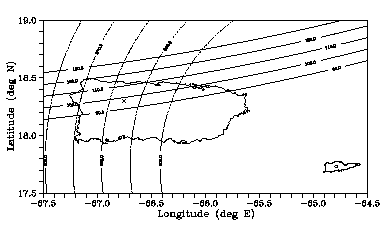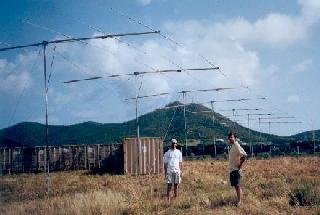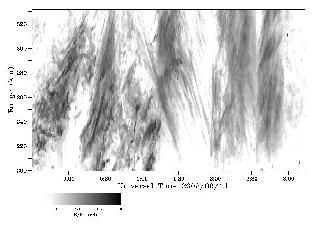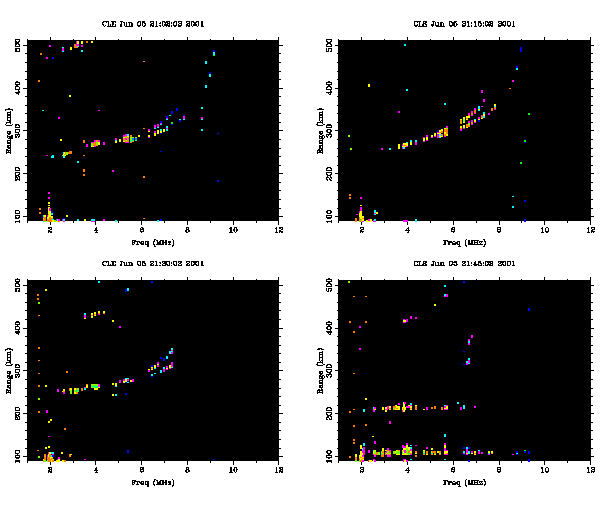 30 MHz portable imaging radar interferometer
30 MHz portable imaging radar interferometer 30 MHz portable imaging radar interferometer
30 MHz portable imaging radar interferometer

|
An investigation of plasma irregularities in midlatitude sporadic E layers was undertaken by M. F. Larsen (Clemson University) and D. L. Hysell (Cornell University) and collaborators in June and July of this year. The investigation focused on so-called quasiperiodic (QP) echoes which were first observed at the MU radar in Japan over a decade ago [Yamamoto et al., 1991, 1992] and have since been observed at other locations in the Pacific, American, and European sectors. Detected principally by VHF coherent scatter radars, QP echoes signify the presence of field aligned plasma irregularities, colocated with sporadic E layers and thought to be generated by a complex interactions between the neutral atmosphere and ionization in the mesosphere and lower thermosphere (MLT) region. The investigation sought to answer three fundamental questions: |
First, what are the processes responsible for generating the QP structures? Several primary mechanisms have been proposed for initiating QP. Some of these rely on various unstable sporadic E layer configurations including tilted layers, multiple layers, and deeply modulated layers. Others stress the roles of the background neutral motion, gravity waves, or Kelvin-Helmholtz billows that develop within the neutral wind shear that generates the sporadic E layer. The small-scale structure that ultimately produces the coherent scatter observed at VHF is assumed to be the gradient drift instability in all three mechanisms, although the QP initiation mechanism will obviously influence how and where the instability condition is satisfied.
Second, what is the range/altitude extent of the QP structures? The simple and commonly used assumption that the VHF backscatter is highly aspect sensitive and maximizes within a fraction of a degree of the direction perpendicular to the magnetic field B leads to a direct proportionality relationship between range and altitude. The measurements made with the MU radar and other coherent scatter radars, which have been interpreted using that simple relationship, suggest that the structures extend from 90 or 95 km altitude to altitudes of 120 to 140 km, and sometimes even 160 km in the lower E region. Sounding rocket measurements are obviously much more limited in both their spatial and temporal coverage than the coherent scatter radar measurements, but the few observations that are available do not show evidence of significant electron density or electric field perturbations above heights of 115--120 km.
Third what is the relationship between the motions of the ionization structures in the sporadic E layer and the range rates and Doppler shifts observed by the coherent scatter radars? The observed Doppler shifts generally differ in magnitude from the range rates, i.e., the range vs. time slopes associated with the QP structures in the radar RTI's, and they are sometimes in opposite directions. Since coherent scatter is produced by wave structure at half the radar wavelength, the motions inferred from the coherent scatter radar observations are the phase speeds of that structure. Interpreting those results without knowing the broader context is difficult.
A series of observations of sporadic E layers and QP echoes was therefore carried out above Puerto Rico using the Arecibo incoherent scatter radar and a coherent scatter radar deployed at the U.S. Virgin Islands National Guard Armory on St. Croix in order to address the three questions listed above. The observations utilized the newly developed dual-beam capability together with azimuth scanning to obtain information about the spatial and temporal variations of the E and F region ionization structures along with their motion. By locating the coherent scatter radar on St. Croix, common volume measurements in the E region above Arecibo were possible. (Figure 1 illustrates the geometry of the experiments.) Furthermore, the coherent scatter radar was configured for in-beam radar imaging, a technique that permits the unambiguous determination of the origin of the coherent scatter in three spatial dimensions. The experiments directly addressed the questions related to the generating mechanism, the altitude extent of the structures, and the relationship between the velocities inferred from coherent scatter measurements and the motions of the ionization.

|
Figure 2 is a photograph of the imaging coherent scatter radar deployed on St. Croix. The portable 30 MHz radar incorporates solid-state transmitters and operates with a modest peak power level of 8 kW. Sensitivity is recovered with the use of a long coded pulses, a high pulse repetition rate, and coherent integration. Coherent scatter from the plasma irregularities in question is also very strong at 30 MHz, and signal-to-noise ratios of the order of 30 dB were observed. Figure 3 shows a representation of coherent scatter received by the radar in range-time-intensity (RTI) format. Examples of QP echoes (the elongated streaks in the plots) and continuous echoes (the diffuse background backscatter) are present in the plot. In this case, echoes were received without interruption for a period of almost 4 hours. |
The 30 MHz radar utilized five antenna arrays for interferometry and radar imaging. True images of the backscatter "brightness" distribution (the distribution of backscatter intensity versus bearing) within the radar illuminated volume can be formed from interferometry data taken with multiple baselines. It is well known that interferometry with a single baseline yields two moments of the brightness distribution. More baselines yield more moments, and a sufficient number of moments define an image in one or two dimensions. Radar range gating adds another spatial dimension. An important feature of in-beam radar imaging that distinguishes it from beam-swinging approaches is that the angular resolution of the technique is limited by the length of the longest interferometry baselines rather than the size of the main antenna array. It is therefore possible in practice to form very high resolution images with interferometry even using small radar systems like the 30 MHz radar which had interferometry baselines as long as 200 m. In-beam ages formed from different Doppler spectral components can be combined into composite images, conveying information about the spectral characteristics of different regions of the illuminated volume. Animated sequences of images reveal how the scatterers evolve over time as they travel through the illuminated volume.
| Using a combination of coherent scatter radar imaging and incoherent scatter dual-beam azimuth scanning, it will be possible to identify the plasma structures in the ionospheric volume over Arecibo responsible for the QP echoes for the first time. Incoherent scatter will also make it possible to monitor the background plasma density, neutral wind, and electric field in which these structures are embedded, allowing us to quantify the instability mechanisms at work. Approximately 1 TB of data were taken between the two radars, which operated together between mid June and early July, 2002, and the research therefore has IT overtones in addition to implications for space science. Data processing is computationally intensive, but early results are anticipated this fall. |

|
CADI (SIL) ionosonde

Ionograms taken during the summer of 2001 can be viewed by accessing this link.
 Return to the
Space Science group homepage.
Return to the
Space Science group homepage.